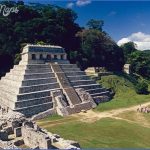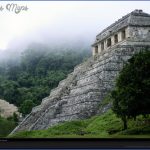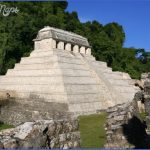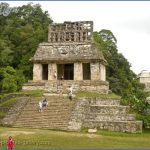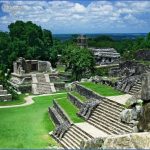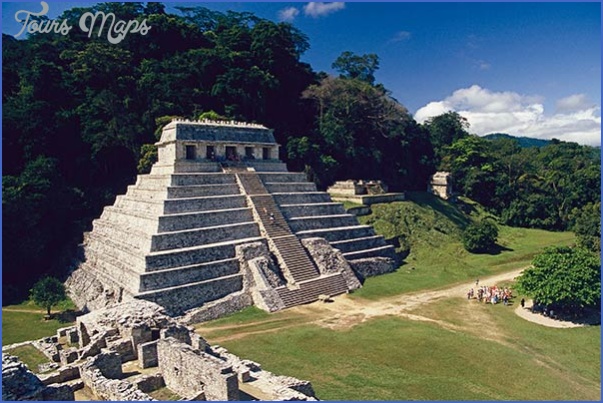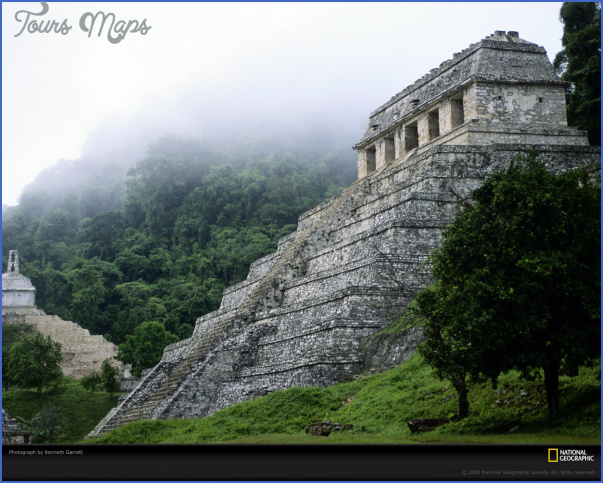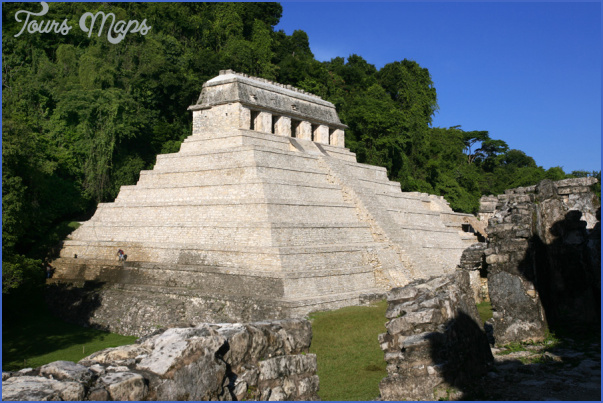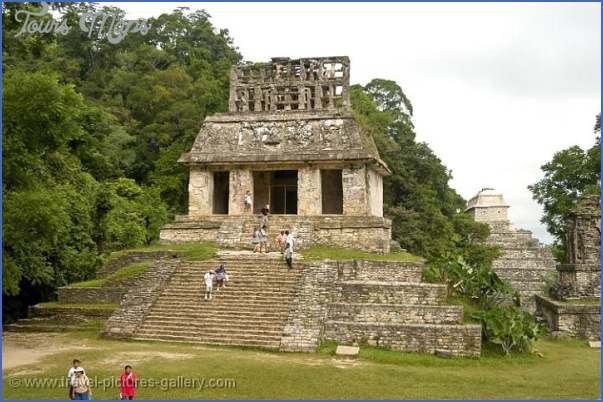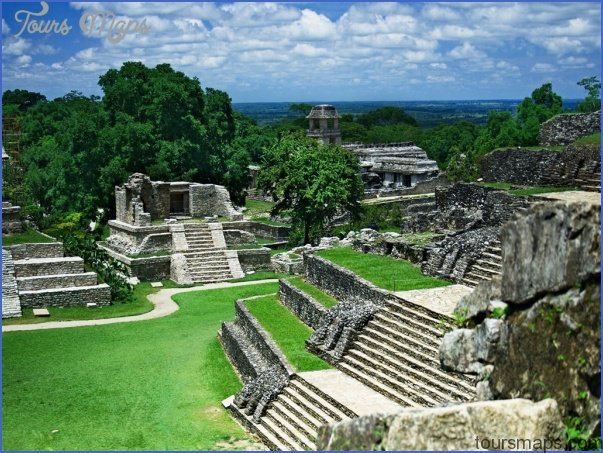ARCHITECT UNKNOWN
Long hidden in the Mexican rainforest, the Temple of the Inscriptions is one of the best examples of religious architecture from the Classic period (c. 250-900) of the Central American Mayan civilization. This large step pyramid rises steeply to about 68ft (21m) high and is crowned by a temple building. The pyramid consists of nine tiers with a central staircase running up one side to the temple on top. Although it has lost most of its original decoration, which would have been in brightly colored stucco, the pyramid is nonetheless a very striking building, dominating one of the central plazas in the ancient city of Palenque.
The most remarkable part of the building, however, is hidden from view. Deep inside it lies the tomb of Palenque’s ruler K’inich Janaab’ Pakal, who reigned over the city for nearly 70 years until his death in 683. The king’s sarcophagus was protected by a heavy, lavishly carved stone lid, and the tomb contained artifacts, including jade jewelry. The monument was begun toward the end of Pakal’s reign and was completed by his son and successor, K’inich Kam B’alam II.
Like most Mayan pyramids, the Temple of the Inscriptions is very tall. Archaeologists believe that its builders wanted to make it visible from afar and to raise the temple up to the sky. The carved reliefs on the piers (supports) that flank the five doorways to the temple and the inscriptions inside, which chronicle Pakal’s reign and give the building its name, are just some of the features that make this such an outstanding structure.
ON SITE
Palenque went into gradual decline after about 800, and the surrounding jungle grew over the site. The city was known only to locals until it was rediscovered in the 1560s by a priest, Lorenzo de la Nada.
Archaeologists began to survey the site in the 18th century. They found the Temple of the Inscriptions near a large building, thought to be the royal Palace, on one of the main plazas. Other temples, houses, and a court for the Mayan ball game were nearby. The proximity of the Temple of the Inscriptions to the Palace signifies just how important it was. Some scholars have suggested that the king looked out at the temple from the Palace tower, a vantage point that would have enabled him to watch the rising sun align with the temple at the winter solstice.
1 Palenque
Visual tour
3 PIERS Four of the piers at the front of the temple were originally richly decorated with stucco reliefs. Now badly worn, the reliefs seem to show standing figures, each of which holds the image of a deity that has one leg in the form of a snake. Thought to depict ancestors, the standing figures are presenting images of the Mayan god of lightning, K’awiil, who could transform his leg into a serpent and who symbolized royal power and regeneration. As Mayan rulers were considered divine, this was fitting imagery for a temple that housed the king’s tomb.
3 STAIRCASE The broad stone steps make the steep ascent from ground level to the temple at the top of the pyramid. Although the steps are wide, it is unlikely that they were used by large numbers of people. The temple, which has five entrances, was a sacred space that was probably the preserve of Mayan priests and the royal family. The size and prominence of the staircase was more to do with emphasizing the importance of the building and to provide a suitably grand setting for the priests as they made their ceremonial ascent.
TEMPLE OF THE INSCRIPTIONS MEXICO 41
1 Pakal’s death mask
ON DESIGN
Constructing a Mayan pyramid and tomb was a huge enterprise involving hundreds of laborers and masons, as well as skilled artists. Several specialists were also employed: carvers, who made inscriptions, carved the sarcophagus lid, and cut decoration into the stonework; workers in stucco, who created the relief panels and made sculptures that have been found on the site; and painters, who decorated the temple in bright colors, traces of which remain. There is also great craftsmanship in Pakal’s remarkable death mask (below), which was fashioned from pieces of jade on a wooden frame and had eyes made of shell and obsidian. The same talented craftsman may also have made the jade bracelets and necklace that were placed on the king’s body.
IN CONTEXT
The city of Palenque had been destroyed in a war in 599 and still needed a great deal of rebuilding work when Pakal came to the throne. The king began this task, and it was continued by his son, who completed the Temple of the Inscriptions and oversaw the construction of the tomb with its elaborately carved sarcophagus. He also boosted the city’s power through alliances and conquests, giving him the resources to continue rebuilding and to finish most of the monuments.
1 Cast of carved sarcophagus lid
2 INSCRIPTION The largest inscriptions in the temple are found on three huge stones on the inner walls. Carved in shallow relief, they are written in the Mayan script, which is made up of semi-pictorial characters known as glyphs. The texts contain more than 600 glyphs and are the longest legible Mayan inscriptions known. It is not easy to translate them because they are worn, but the texts describe the life of Pakal. He became king when just 12 years old after Palenque was attacked and damaged by a rival Mayan army. Pakal rebuilt the city and oversaw its expansion during his long reign. The inscriptions end with the news of the king’s death followed by the name of his heir, Kan B’alam II, who continued Pakal’s great building projects.
3 ENTRANCE TO THE TOMB A narrow stone staircase descends from the temple, through the solid rock of the pyramid, all the way to the tomb at its base. This steep staircase, flanked by roughly finished walls, was designed for use only during the royal entombment. Once the king was buried, it was sealed beneath a slab in the middle of the temple floor. The stairs and tomb were only uncovered in 1952, when an archaeologist noticed that several holes had been drilled in the slab and then blocked with stone plugs. After Pakal was entombed, workers must have lowered the slab carefully into place using ropes looped through the holes. When the slab was positioned securely, they plugged the holes, and the tomb was left completely undisturbed for over a thousand years.
2 TOMB This small chamber at the base of the pyramid was the king’s final resting place. The sloping sides and solid roof were carefully designed to withstand the enormous weight of the stone above. After Pakal had been laid in his stone sarcophagus, it was sealed with a massive stone slab decorated with an image of a young man. Scholars have interpreted this image in various ways, but the consensus is that the young man represents the king portrayed in the likeness of a god and shown on his journey to the next world. Part of Pakal’s entombment ceremony involved sacrificing five of his attendants, whose bodies were left in the tomb before the entrance was blocked with offerings of jade, shell, and pottery, and the stairway filled with rubble and sealed.
TEMPLE PALENQUE, MEXICO Photo Gallery
Maybe You Like Them Too
- The Best Cities To Visit in The World
- World’s 10 Best Places To Visit
- Coolest Countries in the World to Visit
- Travel to Santorini, Greece
- Map of Barbados – Holiday in Barbados

